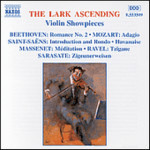
The Lark Ascending: Violin Showpieces
 $25.00
Low Stock
add to cart
$25.00
Low Stock
add to cart
VARIOUS COMPOSERS
The Lark Ascending: Violin Showpieces
Takako Nishizaki 9violin) David Greed (violin) Dong-Suk Kang (violin) and others
[ Naxos / CD ]
Release Date: Thursday 4 September 2003
Should this item be out of stock at the time of your order, we would expect to be able to supply it to you within 4 - 7 business days.
"vividly realised performance......colourful sound confirm this to be among Naxos's finest-ever discs"
- Classic CD
Mozart's Adagio in E major for violin and orchestra, K. 261, was completed in 1776 in Salzburg. It was intended for the use of Antonio Brunetti, the court violinist, who had found the slow movement of Mozart's A major Violin Concerto too artificial and had asked for a movement to replace it. Unlike the original slow movement of the concerto it is scored for flutes instead of oboes, with a pair of horns and the customary string section, and in itself offers music of considerable charm and invention.
The two Romances for violin and orchestra were earlier works of Beethoven. The F major Romance was written in 1798 and the G major work apparently in 1801-2, possibly as slow movements for a C major violin concerto that had been started some years earlier, but was never to be finished. The Romances were published, the a major in 1803 in Leipzig and the F major in Vienna in 1805, after being refused by the distinguished firm of Breitkopf & Härtel, to which they had been offered. They both have a perfection of their own and remain a significant part of the solo violin concert repertoire.
Vaughan Williams wrote his romance for violin and orchestra, The Lark Ascending, in 1914 and revised it after the war. It was dedicated to the violinist Marie Hall, who performed it at the London conference of the British Music Society in June 1921 with the British Symphony Orchestra under Adrian Boult. Based on a poem by George Meredith, the work is rhapsodic in mood, allowing the solo violin to soar above a rural English landscape, aware of what lies below, but pursuing its own course ever higher. The work has no overt programme but expresses the ideals of the English pastoral tradition in its expansion of initial pentatonic thematic material. There is an inevitable air of nostalgia in this work and in other compositions of Vaughan Williams at this period, when, after the horrors of war which he himself had experienced, he returns to a pastoral idyll, a peace and serenity that were now destroyed.
Saint-Saëns added very significantly to violin repertoire, with three concertos for the instrument, in addition to a number of shorter works for violin and orchestra. The most popular of these last is the Introduction and Rondo capriccioso, Opus 28, written in 1863, during his brief period as a piano teacher at the Ecole Niedermeyer. Saint-Saëns dedicated this, as well as his first and third concertos, to the Spanish virtuoso Pablo Sarasate. The Introduction and Rondo capriccioso and the Caprice andalous of 1904 make considerable use of Spanish rhythms and turns of phrase, something to be expected in the second of these two works. The same Spanish element informs the well known Havanaise, written in 1887.
Jules Massenet's Meditation from the opera Thaïs, written in 1894, was arranged for violin and piano by the Belgian violinist Marsick, pupil and successor of Massart at the Paris Conservatoire. Based on the work of Anatole France, Thaïs, typically enough, shows the conversion of 1he four century Egyptian courtesan Thais to Christianity by the monk Athanael, who himself falls victim to her charms, while she, following the example of other Massenet heroines, finds redemption, in this case as a nun.
Tracks:
Wolfgang Amadeus Mozart
Adagio in E major, K. 261
Ludwig van Beethoven
Romance No. 2 in F major, Op. 50
Ralph Vaughan Williams
The Lark Ascending
Camille Saint-Saens
Introduction and Rondo capriccioso, Op. 28
Havanaise, Op. 83
Jules Massenet
Thais, Act II: Meditation
Maurice Ravel
Tzigane
Pablo de Sarasate
Zigeunerweisen, Op. 20



